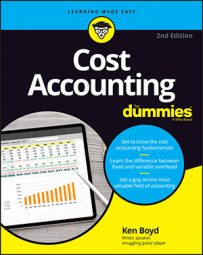In cost accounting, practical capacity is the maximum level of capacity you can handle, taking into account unavoidable delays. Unavoidable delays might include the facts that your production staff takes vacation and that you need to schedule repair and maintenance to maintain your equipment. After accounting for those types of production stoppages, you can calculate practical capacity.
Practical capacity views your production level from the supply side — not the demand side. “What if my department had all of the work it could handle? How would that level of production look?” That’s what you ask yourself when you’re using practical capacity to determine cost allocation rates.
Consider the impact of using practical capacity for single rate and dual rate cost allocations. There is some fallout, because cost allocations may change. Those changes may affect decisions your managers make.
Say you operate a marketing company. You service clients in the financial services market and the medical market, and you have separate divisions to service each of them. The printing and web services department supports both divisions, providing all printed ads, marketing pieces, and websites designed for clients.
Costs are allocated based on each division’s usage in hours. In planning, you determine that the financial services division needs 2,000 hours and the medical division needs 1,800 hours.
The first table shows the budgeted cost pool, using budgeted usage (hours).
| Fixed costs | $2,500,000 | |
| Variable costs | ||
| Variable cost per unit | $210 | |
| Budgeted hours | 3,800 | |
| Total variable costs | $798,000 | |
| Total cost pool | $3,298,000 |
Your single rate budgeted cost allocation rate is
Single rate budgeted cost allocation rate = cost pool ÷ budgeted hours
Single rate budgeted cost allocation rate = $3,298,000 ÷ 3,800
Single rate budgeted cost allocation rate = $868 per hour (rounded)
Now consider just the fixed cost portion of the cost allocation. The cost allocation rate is $658 per hour ($2,500,000 ÷ 3,800 rounded).
Next, you take a look at the same calculation, using practical capacity. You “put the pedal to the metal” by maxing out your available hours for providing marketing support. You determine that the financial services division can generate 2,500 hours, and the medical division can generate 2,000 hours.
| Fixed costs | $2,500,000 | |
| Variable costs | ||
| Variable cost per unit | $210 | |
| Practical capacity hours | 4,500 | |
| Total variable costs | $945,000 | |
| Total cost pool | $3,445,000 |
Consider what’s changed. The practical capacity hours are higher than budgeted hours (4,500 versus 3,800). It should make sense that the total variable cost goes up ($945,000 versus $798,000), because you multiply the variable cost per unit by the practical capacity hours.
Your single rate budgeted cost allocation rate is
Single rate budgeted cost allocation rate = $3,445,000 ÷ 4,500
Single rate budgeted cost allocation rate = $766 per hour (rounded)
Now consider just the fixed cost portion of the cost allocation. The cost allocation rate is $556 per hour ($2,500,000 ÷ 4,500 rounded).
The single cost allocation rate is multiplied by actual hours (usage) to apply costs to each division. Multiply the practical capacity rate of $766 by the actual hours used to calculate the cost allocation for each division.
What you’ve just seen is an example of the risks of looking at fixed costs per unit. The practical capacity fixed cost allocation ($556 per hour) is lower than the fixed rate at budgeted capacity ($658 per hour). Lower costs are always better.
Keep in mind, however, that the only reason the fixed cost per unit is lower is because you’re spreading the same dollar amount ($2,500,000 in fixed costs) over a higher number of hours. You have to cover your fixed costs, come what may. If you don’t, you can’t generate a profit.

